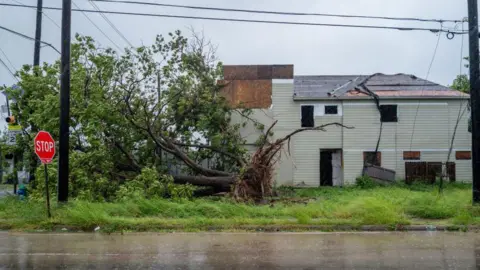By Kathryn Armstrong and Brandon Drenon, BBC News
At least two people died as Hurricane Beryl struck southeast Texas, knocking out power to more than two million people while bringing heavy rain and strong winds.
When Beryl first hit Texas Monday morning, it was classified as a Category 1 hurricane, but has since been downgraded to a tropical storm.
Authorities have warned of damaging winds, up to 15 inches of rain and “potentially life-threatening” storm surges.
More than 1,300 flights have been canceled at Houston’s largest airport.
The state governor’s office has repeatedly urged residents not to underestimate the storm, which caused at least 10 deaths in the Caribbean days earlier.
In Texas, a 53-year-old man died after high winds downed power lines and caused a tree to fall on his home in Harris County, causing his roof to collapse.
In the same county, which includes parts of Houston, a 74-year-old woman was also pronounced dead after a tree fell through the roof of her home. Police were notified by the woman’s granddaughter.
On Monday, police in a Houston suburb had already begun conducting water rescue operations as the hurricane continued to batter the state.
According to US forecaster AccuWeather, landfalling hurricanes of this type are quite rare in Texas in July.
Houston is a low-lying coastal city, making it prone to flooding.
Sustained wind speeds in the Houston area reached 75 mph (120 km/h) with gusts reaching 87 mph (140 km/h).
Torrential rains and flash floods also occurred in areas where centimetres of rain fell in just a few hours.
The storm is expected to lose strength as it moves gradually north-northeast, but flash flooding and heavy rain remain a risk.
According to poweroutage.us, more than 2.7 million customers in Texas were without power as of Monday afternoon.
At Bush Intercontinental Airport, Houston’s largest airport, 1,097 flights were canceled, according to flightaware.com.
 Getty Images
Getty ImagesAs the storm moved toward Houston, tornado warnings were issued for dozens of other Texas counties along its path, including a few Louisiana counties.
“Take cover now!” the National Weather Service warned in its weather advisory around 1 p.m. CDT (7 p.m. BST) for residents of Beauregard Parish in northeastern Louisiana.
“Move to an interior room on the ground floor of a solid building. Avoid windows.”
Earlier, the city of Galveston, southeast of Houston, issued a voluntary evacuation order for certain areas.
Storm surges in the Galveston area are expected to reach 4 to 6 feet above ground level.
In Surfside Beach, police released a photo of floodwaters rising above the bottom of a truck door, just a few feet above the ground.
U.S. National Hurricane Center Director Michael Brennan warned people in Beryl’s path to find a safe place to take shelter until Monday, “as dangerous conditions will persist even after the center of Beryl passes.”
“There is a very significant risk of flash flooding on the Texas Gulf Coast, East Texas and the ArkaTex (Arkansas-Texas) region.
“Do not ignore this very serious storm,” Acting Gov. Dan Patrick urged.
The ports of Corpus Christi, Houston, Galveston, Freeport and Texas City have all been closed, meaning there could be a temporary halt to exports.
All ship movements and cargo operations have been restricted.
Refugio County, north of Galveston, issued a mandatory evacuation Saturday — citing limited emergency personnel capacity, July 4 holiday traffic and weakened infrastructure in the area from Hurricane Harvey in 2017 as reasons.
Nueces County, meanwhile, has ordered a mandatory evacuation of visitors and strongly encouraged residents to leave as well.
More than 2,000 emergency responders have been mobilized to deal with Beryl’s aftermath, Patrick said, including members of the Texas National Guard.
Beryl is expected to move eastward across the central United States, including Mississippi, later this week.
In doing so, it will likely avoid central and west Texas, regions currently experiencing moderate to severe levels of drought.
 International Organization for Migration/Reuters
International Organization for Migration/ReutersHurricane Beryl was an unprecedented storm. At one point, it became the earliest Category 5 hurricane on record.
It has already left a devastating trail across the Caribbean, hitting islands including Saint Vincent and the Grenadines, Mayreau and Union, and Grenada particularly hard.
The storm was also one of the most powerful to ever hit Jamaica and left hundreds of thousands of people without power.
Beryl brought heavy rains to the tourist hotspots of Cancun and Tulum in southern Mexico. No major damage was reported, but strong winds downed trees and caused power outages.
Although it is difficult to attribute specific storms to climate change because the causes are complex, unusually high sea surface temperatures are considered a major reason why Hurricane Beryl was so powerful.
It is the first hurricane of the 2024 Atlantic season, but the US National Oceanic and Atmospheric Administration (NOAA) has warned that the North Atlantic could see up to seven major hurricanes this year, compared to an average of three per season.



